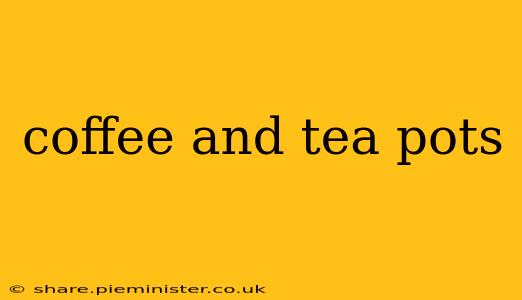The humble teapot and coffee pot are far more than simple vessels; they're crucial components in the ritual of enjoying a perfect cup. Choosing the right pot can significantly impact the flavor and experience of your beverage. This guide dives into the world of coffee and tea pots, exploring the various types, materials, and considerations for selecting the perfect pot for your needs.
What are the different types of coffee pots?
The coffee pot landscape is vast, ranging from simple stovetop percolators to sophisticated automatic drip machines. Here are some of the most popular types:
-
Automatic Drip Coffee Makers: These are the workhorses of many kitchens, offering convenience and consistent results. They typically use a filter basket to brew coffee directly into a carafe. Variations exist in features like programmable timers and thermal carafes.
-
Pour Over Coffee Makers: These manual brewers emphasize control and precision. Hot water is slowly poured over coffee grounds in a filter, resulting in a highly customizable brew. Popular pour-over devices include Hario V60, Chemex, and Kalita Wave.
-
French Press: This immersion method steeps coffee grounds directly in hot water. The resulting brew is full-bodied and rich, but it can also contain more sediment than other methods.
-
Moka Pot (Stovetop Espresso Maker): This stovetop brewer produces a concentrated coffee similar to espresso, though not technically espresso. It's a popular choice for its compact size and ability to brew rich coffee without electricity.
-
AeroPress: This portable and versatile brewer combines elements of immersion and pressure brewing, yielding a clean and flavorful cup.
What are the different types of teapots?
The world of teapots is equally diverse, each designed to optimize the brewing process for different types of tea. Popular types include:
-
Cast Iron Teapots: These retain heat exceptionally well, ideal for brewing pu-erh or other teas that benefit from prolonged steeping at higher temperatures.
-
Ceramic Teapots: These come in a vast array of shapes, sizes, and designs, offering good heat retention and aesthetic appeal.
-
Glass Teapots: These allow for visual appreciation of the brewing process and are generally easy to clean. However, they don't retain heat as well as ceramic or cast iron.
-
Stainless Steel Teapots: These are durable, easy to clean, and resistant to staining. They are less effective at retaining heat than ceramic or cast iron.
-
Yixing Teapots (Clay Teapots): These are highly prized for their ability to imbue the tea with subtle earthy notes over time. Proper care is crucial to maintain their quality.
What material is best for a coffee pot?
The best material for a coffee pot depends on your priorities. Stainless steel is durable, easy to clean, and doesn't affect the taste of coffee. Glass carafes allow for easy viewing of the brewing process. However, ceramic coffee pots offer excellent heat retention for those who want to keep their coffee warm for longer.
What material is best for a teapot?
Similar to coffee pots, the optimal teapot material hinges on personal preferences and the type of tea being brewed. Cast iron excels at heat retention, while glass provides visual appeal. Ceramic offers a balance of heat retention and aesthetic options. Stainless steel is practical for its durability and ease of cleaning. Yixing clay offers a unique brewing experience but demands careful handling and maintenance.
How do I clean my coffee pot?
Cleaning your coffee pot regularly prevents the buildup of coffee oils and residue, maintaining both its function and hygiene. Most coffee pots can be safely cleaned in a dishwasher, but always check the manufacturer's instructions. For stubborn stains, a solution of baking soda and water can be effective.
How do I clean my teapot?
Cleaning your teapot depends on the material. Glass and stainless steel teapots are usually dishwasher-safe. Ceramic teapots are best hand-washed to avoid damage. For cast iron teapots, avoid using soap, as this can strip the seasoning. Rinse thoroughly with hot water after each use.
What size coffee pot should I buy?
The ideal coffee pot size depends on how much coffee you typically brew. Consider the number of people you usually serve and choose a pot that accommodates their needs, with a little extra capacity for guests.
What size teapot should I buy?
The appropriate teapot size depends on the number of teacups you want to fill. Consider the capacity needed and choose a teapot accordingly. Remember to leave space for tea leaves to expand during brewing.
This guide provides a starting point in your journey toward brewing perfection. Remember to consider your brewing method, preferred materials, and personal preferences when choosing your next coffee or tea pot. Happy brewing!
